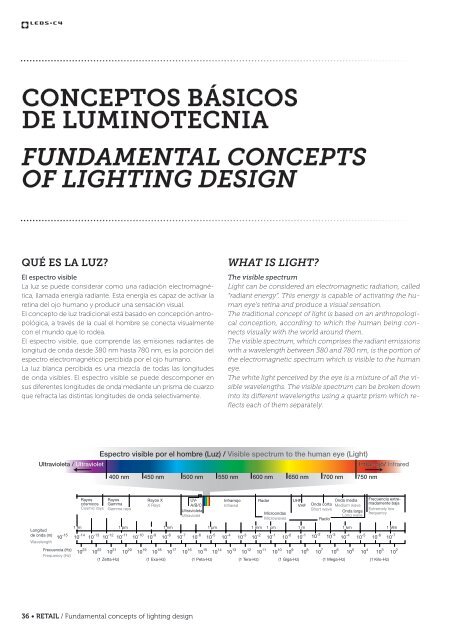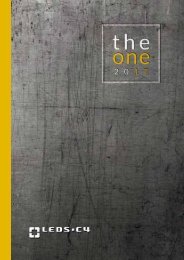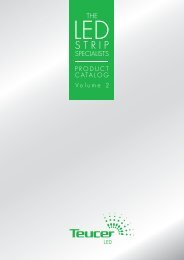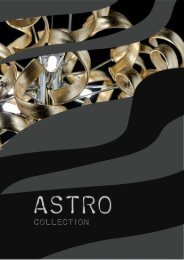RETAIL_2016
You also want an ePaper? Increase the reach of your titles
YUMPU automatically turns print PDFs into web optimized ePapers that Google loves.
CONCEPTOS BÁSICOS<br />
DE LUMINOTECNIA<br />
FUNDAMENTAL CONCEPTS<br />
OF LIGHTING DESIGN<br />
QUÉ ES LA LUZ?<br />
El espectro visible<br />
La luz se puede considerar como una radiación electromagnética,<br />
llamada energía radiante. Esta energía es capaz de activar la<br />
retina del ojo humano y producir una sensación visual.<br />
El concepto de luz tradicional está basado en concepción antropológica,<br />
a través de la cual el hombre se conecta visualmente<br />
con el mundo que lo rodea.<br />
El espectro visible, que comprende las emisiones radiantes de<br />
longitud de onda desde 380 nm hasta 780 nm, es la porción del<br />
espectro electromagnético percibida por el ojo humano.<br />
La luz blanca percibida es una mezcla de todas las longitudes<br />
de onda visibles. El espectro visible se puede descomponer en<br />
sus diferentes longitudes de onda mediante un prisma de cuarzo<br />
que refracta las distintas longitudes de onda selectivamente.<br />
WHAT IS LIGHT?<br />
The visible spectrum<br />
Light can be considered an electromagnetic radiation, called<br />
“radiant energy”. This energy is capable of activating the human<br />
eye’s retina and produce a visual sensation.<br />
The traditional concept of light is based on an anthropological<br />
conception, according to which the human being connects<br />
visually with the world around them.<br />
The visible spectrum, which comprises the radiant emissions<br />
with a wavelength between 380 and 780 nm, is the portion of<br />
the electromagnetic spectrum which is visible to the human<br />
eye.<br />
The white light perceived by the eye is a mixture of all the visible<br />
wavelengths. The visible spectrum can be broken down<br />
into its different wavelengths using a quartz prism which reflects<br />
each of them separately.<br />
Espectro visible por el hombre (Luz) / Visible spectrum to the human eye (Light)<br />
Ultravioleta / Ultraviolet<br />
Infrarrojo/ Infrared<br />
400 nm<br />
450 nm 500 nm 550 nm 600 nm 650 nm 700 nm 750 nm<br />
Rayos<br />
cósmicos<br />
Cosmic rays<br />
Rayos<br />
Gamma<br />
Gamma rays<br />
Rayos X<br />
X Rays<br />
UV-<br />
A/B/C<br />
Ultravioleta<br />
Ultraviolet<br />
Infrarrojo<br />
Infrared<br />
Radar<br />
Microondas<br />
Microwaves<br />
UHF<br />
VHF<br />
Onda media<br />
Onda corta Medium wave<br />
Short wave<br />
Onda larga<br />
Long wave<br />
Radio<br />
Frecuencia extremadamente<br />
baja<br />
Extremely low<br />
frequency<br />
Longitud<br />
de onda (m)<br />
Wavelength<br />
10 -15 10 -14 10 -13 10 -12 10 -11 10 -10 10 -9 10 -8 10 -7 10 -6 10 -5 10 -4 10 -3 10 -2 10 -1 10 -0 10 -1 10 -2 10 -3 10 -4 10 -5 10 -6 10 -7<br />
10 23 10 22 10 21 10 20 10 19 10 18 10 17 10 16 10 15 10 14 10 13 10 12 10 11 10 10 10 9 10 8 10 7 10 6 10 5 10 4 10 3 10 2<br />
Frecuencia (Hz)<br />
Frequency (Hz)<br />
1 fm 1 pm 1 nm 1 μm<br />
1 mm 1 cm 1 m 1 km 1 Mm<br />
(1 Zetta-Hz)<br />
(1 Exa-Hz) (1 Peta-Hz) (1 Tera-Hz) (1 Giga-Hz) (1 Mega-Hz) (1 Kilo-Hz)<br />
36 • <strong>RETAIL</strong> / Fundamental concepts of lighting design









